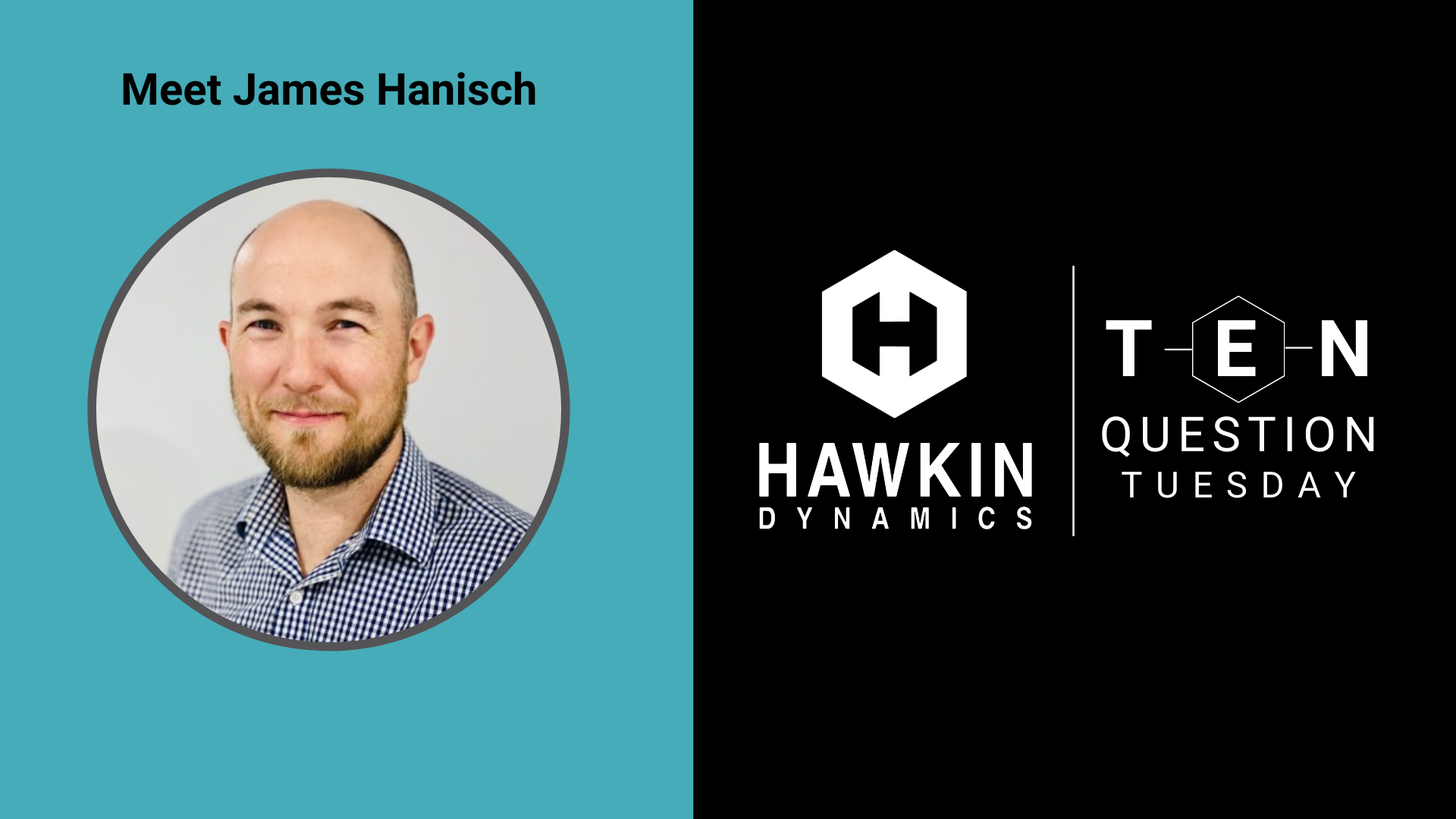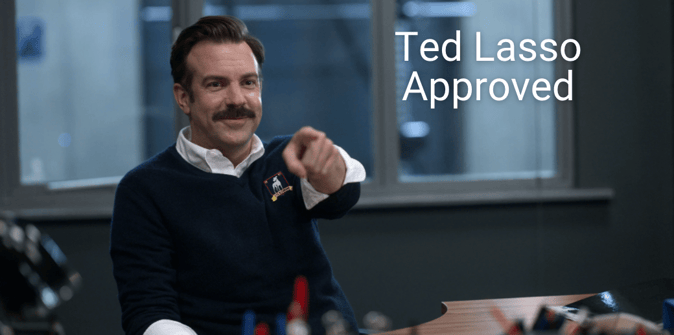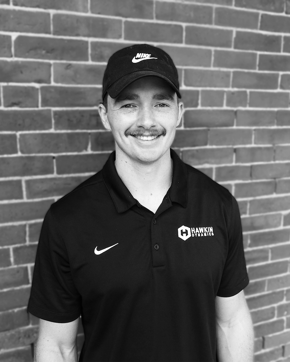What is 10 Question Tuesday?
This is the first of many "Ten Question Tuesday" posts. Ten Question Tuesday (TQT) is where we interview the world's best practitioners, coaches, and people to pick their brains, learn from their experiences, and get it all on paper. This is Ten Question Tuesday brought to you by Hawkin Dynamics.
Who is James Hanisch?
James Hanisch is a Customer Support Specialist and Sport Scientist for Hawkin Dynamics Asia-Pacific (located in Adelaide, Australia). Previously, he was the Director of Performance Science for the Philadelphia Eagles (NFL), University of Oregon Sport Science Coordinator, and Brisbane Lions Performance Analyst. Learn more about his previous work experience below.

Question 1
Hawkin Dynamics: Hi James, please share a little bit about your background up to this point!
James: I’m an Australian, I grew up in Adelaide as a sports-loving kid and ended up completing a Bachelor of Applied Science in Human Movement at the University of South Australia. I was lucky enough to be chosen for an internship at the Port Adelaide Football Club in the first semester of the final year of my degree. I spent the second semester of that final year on an exchange program at Colorado State University in the US with two other friends from the course. I truly believe that taking educated risks is extremely important. Making yourself uncomfortable exposes your weaknesses and it can define who you are and your philosophies and the exchange certainly puts you outside your comfort zone.
After returning to Adelaide, I interviewed for an intern position with the Adelaide Football Club and began my journey in strength and conditioning and sports science. I thoroughly enjoy the use of technology in sport and trying to problem solve under high pressure situations. Objective data can be used in a variety of ways from education to setting benchmarks for success overtime, and my time at Adelaide Football Club under Stephen Schwerdt and Neil Craig set the tone for my career. Specifically in regards to feedback in coaching and the data utilization space.
After my time at Adelaide Football Club, I then moved to the Brisbane Lions Football Club and two years later I was approached by the University of Oregon to run their newly formed sports science program. I cannot speak more highly of my time in Oregon. Yes, there is the glitz and glamour of Nike and the facilities, but the people made Oregon an extremely special place to work.
I then had the opportunity to work at the Philadelphia Eagles where I joined an incredible staff and organization. I spent 7-years in Philadelphia with the Eagles, had three children, completed my Masters in High Performance Sport, and continued to develop my philosophies in performance and sport science.
Finally, I conclude the story on my background with Hawkin Dynamics, - being able to come back to Adelaide, and spearhead a subsidiary business here in the Asia-Pacific has been an incredible experience thus far. I am really excited to continue this journey and innovate the space in this region of the world and push the boundaries of a great company. I have been a user of Hawkin, and knew before I joined the team, the exemplary character of the people, the standard of the technology and software; as well as the drive and direction as a company.
All in all, absolutely thrilled to work at Hawkin and to work with a great team of people focused on integrating and elevating the application of objective human movement.
Question 2
Hawkin Dynamics: You were a customer first. During your time with the Philadelphia Eagles, how did you use the Hawkin Dynamics Force Plates?
James: I have been very fortunate to work in two elite organizations (University of Oregon, and the Philadelphia Eagles) where there has been tremendous support for pushing the boundaries in terms of the level of service and commitment we provide to the athletes.
Force plates have been a huge component of what I would consider the top tier objective measures in performance analysis. I have used force plates for weekly monitoring, benchmarking, fatigue measurement, performance output and rehabilitation. Force plates have been ingrained in my daily use. Force plates allow you to analyze what you can’t see with the naked eye and that is the micro changes in performance. This is monitoring.
The human body is tremendously adaptable and finds ways to compensate. The force plate allows you to see nuances in output that allow for changes to individual programming. In Rehabilitation, I have used force plates to show incremental changes throughout the rehabilitation process for both lower and upper body injuries. How does the body respond to an increase in loading over a four-week block, or running on land again after a lower limb surgery. Typically, I would see a step progression of asymmetry and performance output. Being able to objectify the rehabilitation process and provide benchmarking details gives clarity for decision-makers in return to train and play protocols while also giving athletes more confidence to perform knowing they are outputting similar markers to previous non-injured data. In regards to Athlete Development, being able to adapt programming to get the most out of your athletes from an early training age is key. One of the areas that showed significant benefit was the Quadrant Report. Being able to highlight two metrics and see real change after designing strength & conditioning blocks was key to player development. For example, if we noticed that a first-year athlete was on par with his peers in his explosiveness, but needed to generate more peak force we could adjust his programming based on the objective data to focus on force development adaptation and review his data again after four weeks to see if we were on the right path. If not, we adjust his program again and retest.
Question 3
Hawkin Dynamics: During your time as a coach, why did you choose to join Hawkin Dynamics over other sport technology companies?
James: For me and the team at the time, we saw Hawkin as the leader in the field. There is the ease of use without compromising on reliability, which was a major factor in choosing Hawkin over their competitors. Working in an elite sport, you need a system that is reliable and easy to use from not only the point of view of the tester but also the athletes.
Hawkin also designed software that takes complex data and makes it easy to digest, interpret, download, and send to staff and players. Simply, I was able to conduct tests and immediately action the information to make meaningful changes. There is no product on the market that has this process dialed in like Hawkin.
The second main point is customer care. From the first day, the people at Hawkin were on top of everything and they continued to check in. Time is the ultimate factor and Hawkin delivers a product and experience with their staff and support that saves you time.
Question 4
Hawkin Dynamics: You’re from Australia and recently returned, how much different is human performance in Australia vs. the United States?
James: This is a very complex question. In the US, there is an interesting play between strength and conditioning and sport science. Strength and Conditioning is a cornerstone of the sporting culture, the staff are treated with respect and are viewed as coaches, dictating programming and carrying the ethos of the head coach. The study and foundation of strength and conditioning principles are sound and the knowledge base is high.
In Australia, sport science is similar; it has been a cornerstone of programs in Australia for decades and is commonplace in both professional and amateur sport. It is a highly researched area in Australia, ever-evolving and always adapting.
The medical system in both countries differs significantly and brings about their own separate challenges. The legal system in regards to medical care in the US, along with rigid post-surgical methodologies, hinders the maximization of performance gains, but it does give clear direction on who is ultimately responsible for athlete care.
Both countries have their own developed philosophies on training and performance. The key is to check your ego at the door, develop an understanding of the culture, respect each person's skillset and knowledge, and apply that knowledge to improve performance for both athletes and staff.
That truly is the benefit of working and collaborating with people from different backgrounds and cultures as you can learn new concepts, ways of thinking, and applications to your own processes.
Question 5
Hawkin Dynamics: Where do you see sport science going in the next 3, 5, and 10 years?
James: Time, Simplification, and Security.
I believe over the next 10-years we are going to see that time is everything. Being able to take complex data sets and providing adaptable, and easy to digest reporting will be the new standard. The quicker a decision is made on one problem, the faster the next decision can be made on the next.
Security is going to be a major focus over the next 10 -years as well. The integration of personal data with performance data will continue and who gets to see and interpret that data will become increasingly important.
Decisions on contracts are going to include data from sport science in their portfolio. For instance, what is this athlete’s habits off the field? Do they sleep well? What does their blood chemistry look like? What is their gut microbiome and how does that relate to overall longevity in their particular sport? There are going to be major questions on who can see what data, and security is it going to be of the upmost importance. This is also going to give power to who owns the data, being able to leverage the data to show their commitment, output, and resilience overtime.
Question 6
Hawkin Dynamics: One of the biggest barriers for performance coaches and sport scientists is reporting back to the head sport coach and sport staff. How did you successfully accomplish this?
James: There are a few ways to accomplish this communication pathway. Firstly, you have to give yourself time to understand the culture and philosophies of the coach and staff and understand what is important to them.
I would call the next step, ‘micro wins’. You have to build rapport with the coaches and staff by giving answers that build trust, so that when you give information it is almost like you are providing them with confirmation and validation of their own thought processes.
For example, if you know that the coach thinks that one of the veteran players is the strongest on the team, and this is actually true, show him/her a report and say, "Hey, this veteran player did the highest squat of any player we have had on our roster". That is a quick and easy way to show you are collecting data, but also to highlight some information that can be used in a team meeting, or a one-on-one conversation later. Once you have stacked a few of those ''Micro wins' together, you can try with a note that might influence the program: ‘"Hey coach, what do you think if we cut practice down by 10 minutes tomorrow, the information I have here shows we are pushing close to the edge right now".
Developing relationships with key stakeholders is the key to any successful sport science program, and you also need to be ok with not getting exactly what you want as there are always two sides of a coin. Check that ego at the door and enjoy the process. Collaboration is king and understanding that every person in the building has the best interest of the team at heart, that is how you need to approach every day.
Question 7
Hawkin Dynamics: You have little ones. How will you ensure they grow up and develop all of the physical qualities they need to be successful if they choose to participate in sports.
James: We want them to participate and compete in sports that make them happy and make them feel part of something bigger than themselves. Teamwork and good sportsmanship are really important to my wife and I as our kids sporting lives evolve.
We’ll ensure they are properly fueled from a nutrition point of view and as things get more serious we’ll make sure they recover properly and look after their bodies. Importantly, we want them to earn all of their successes and learn from their mistakes, and we hope to instill in them that every opportunity to practice and play is a chance to get better.
Question 8
Hawkin Dynamics: How did your experience with the Brisbane Lions & Adelaide prepare you for working with American football?
James: It was really about developing my skillset. At that time, I was still early in my career. I was a sponge and learned from all the people around me. As with anyone, those early days really shape your view of the industry, but the working environments and cultures are so different. It took quite some time to adjust to the American culture of sports, there is a different level of intensity in the US; that of which I had briefly experienced from my time as a student at Colorado State University.
One area I was ill-prepared for is the corporate nature of sports in the US. The Australian and US cultures are very different in respect to optics and require a short learning curve.
Question 9
Hawkin Dynamics: How did you first get connected with the Oregon Ducks football team from Australia?
James: I was fortunate to form great relationships with people in the industry both at sporting organizations and technology companies throughout my career. A company I had worked closely with for years had built a good relationship with Oregon and they had identified me as someone that would fit their program. Seemingly out of the blue though, I was contacted by one of the staff at Oregon to apply for a new role they’d created in Sport Science. Within a couple of weeks, I was interviewed and had the role.
Question 10
Hawkin Dynamics: Last question, with the official launch of HD Asia-Pacific location, can you tell us a little bit about the location and your plans to bring the world’s fastest growing force plate to a new region of the globe?
James: Absolutely! I am extremely excited to launch Hawkin Dynamics Asia-Pacific. We have our headquarters in Adelaide, Australia.
We are developing a framework for both the Australia/New Zealand and Asia Markets. Our focus will be on bringing a solution that is accurate, reliable, and extremely easy to use while wrapping that in with elite customer service. Nothing changes in terms of our support and commitment as a company - if anything, it only enhances our footprint worldwide.
We are passionate about our technology, our software, and our commitment to each and every one of our customers. Helping people maximize and gain the absolute most out of the technology we provide is essential in any applications from professional sports, military, private facilities, and allied health to aged care. It is all about creating a network of users that are equally as passionate as we are.
I am beyond thrilled to bring this technology to the Asia-Pacific and for people to join the #HawkinFamily.
That's A Wrap
That's all for this Ten Question Tuesday #1. If you would like to follow James you can find him on Twitter here and also LinkedIn here.
James was also recently a guest on The Hawkin Podcast - give this episode a listen in your free time! Until next time, The HD Team.

-2.png?width=156&height=60&name=Hawkin%20Logo%20(2)-2.png)
-1.png?width=155&height=60&name=WHITE.Horizontal_Logo.Transparent%20(3)-1.png)

